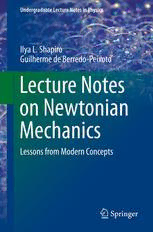Table Of ContentUndergraduate Lecture Notes in Physics
Ilya L. Shapiro
Guilherme de Berredo-Peixoto
Lecture Notes
on Newtonian
Mechanics
Lessons from Modern Concepts
Undergraduate Lecture Notes in Physics
Forfurthervolumes:
http://www.springer.com/series/8917
UndergraduateLectureNotesinPhysics(ULNP)publishesauthoritativetextscov-
ering topics throughout pure and applied physics. Each title in the series is suit-
ableasabasisforundergraduateinstruction,typicallycontainingpracticeproblems,
workedexamples,chaptersummaries,andsuggestionsforfurtherreading.
ULNPtitlesmustprovideatleastoneofthefollowing:
• An exceptionally clear and concise treatment of a standard undergraduate
subject.
• Asolidundergraduate-levelintroductiontoagraduate,advanced,ornonstandard
subject.
• Anovelperspectiveoranunusualapproachtoteachingasubject.
ULNPespeciallyencouragesnew,original,andidiosyncraticapproachestophysics
teachingattheundergraduatelevel.
ThepurposeofULNPisto provideintriguing,absorbingbooksthatwillcontinue
tobethereaderspreferredreferencethroughouttheiracademiccareer.
Series Editors
NeilAshby
Professor,ProfessorEmeritus,UniversityofColoradoBoulder,CO,USA
WilliamBrantley
Professor,FurmanUniversity,Greenville,SC,USA
MichaelFowler
Professor,UniversityofVirginia,Charlottesville,VA,USA
MichaelInglis
Professor,SUNYSuffolkCountyCommunityCollege,Selden,NY,USA
ElenaSassi
Professor,UniversityofNaplesFedericoII,Naples,Italy
HelmySherif
ProfessorEmeritus,UniversityofAlberta,Edmonton,AB,Canada
Ilya L. Shapiro • Guilherme de Berredo-Peixoto
Lecture Notes on Newtonian
Mechanics
Lessons from Modern Concepts
123
IlyaL.Shapiro GuilhermedeBerredo-Peixoto
DepartamentodeFisica–ICE DepartamentodeFisica–ICE
UniversidadeFederaldeJuizdeFora UniversidadeFederaldeJuizdeFora
JuizdeFora,Brazil JuizdeFora,Brazil
TomskStatePedagogicalUniversity
Tomsk,Russia
ISSN2192-4791 ISSN2192-4805(electronic)
ISBN978-1-4614-7824-9 ISBN978-1-4614-7825-6(eBook)
DOI10.1007/978-1-4614-7825-6
SpringerNewYorkHeidelbergDordrechtLondon
LibraryofCongressControlNumber:2013940515
©SpringerScience+BusinessMedia,LLC2013
Thisworkissubjecttocopyright.AllrightsarereservedbythePublisher,whetherthewholeorpartof
thematerialisconcerned,specificallytherightsoftranslation,reprinting,reuseofillustrations,recitation,
broadcasting,reproductiononmicrofilmsorinanyotherphysicalway,andtransmissionorinformation
storageandretrieval,electronicadaptation,computersoftware,orbysimilarordissimilarmethodology
nowknownorhereafterdeveloped.Exemptedfromthislegalreservationarebriefexcerptsinconnection
with reviews or scholarly analysis or material supplied specifically for the purpose of being entered
and executed on a computer system, for exclusive use by the purchaser of the work. Duplication of
this publication or parts thereof is permitted only under the provisions of the Copyright Law of the
Publisher’slocation,initscurrentversion,andpermissionforusemustalwaysbeobtainedfromSpringer.
PermissionsforusemaybeobtainedthroughRightsLinkattheCopyrightClearanceCenter.Violations
areliabletoprosecutionundertherespectiveCopyrightLaw.
Theuseofgeneraldescriptivenames,registerednames,trademarks,servicemarks,etc.inthispublication
doesnotimply,evenintheabsenceofaspecificstatement,thatsuchnamesareexemptfromtherelevant
protectivelawsandregulationsandthereforefreeforgeneraluse.
Whiletheadviceandinformationinthisbookarebelievedtobetrueandaccurateatthedateofpub-
lication,neithertheauthorsnortheeditorsnorthepublishercanacceptanylegalresponsibilityforany
errorsoromissionsthatmaybemade.Thepublishermakesnowarranty,expressorimplied,withrespect
tothematerialcontainedherein.
Printedonacid-freepaper
SpringerispartofSpringerScience+BusinessMedia(www.springer.com)
Preface
ClassicalMechanicsisafirststepforthosewhobegintostudyTheoreticalPhysics.
One can say thatin this case, as in manyother situationsof life, the first step can
be the most importantone. In fact, the same subjects which are dealt with first in
Mechanicsaresometimesapproachedafterwardsinmoreadvancedcoursessuchas
Electrodynamics, Quantum Mechanics and Statistical Mechanics. Of course, the
same concepts appear to be more sophisticated and sometimes more interesting
when formulated in these frameworks. At the same time these formulations may
also be more difficult. For this reason, the student who knowswell Classical Me-
chanicscanstudyotherpartsofTheoreticalPhysicseasierandperhapsbetter.
The course of Classical Mechanicsfor Physicsstudentsis traditionallydivided
intwoparts.Thefirstoneistechnicallysimplerthanthesecondone,whichisalso
called Analytical Mechanics. In the secondpart, the mathematicaland theoretical
toolsare more complicatedand this allows us to consider the notionsof Mechan-
ics in a more general and profound way. At the same time, for many students, it
is importantto start the studyof AnalyticalMechanicswith an appropriateprepa-
ration,and for this reasonthe one-semesterintroductoryphysicscourseis usually
notenough.Toaddressthissituation,thereisusuallyacourseofClassicalMechan-
ics, which is somehow intermediate between introductory Physics and Analytical
Mechanics.Suchanintermediatecourseisthesubjectofthepresentbook.Anim-
portantdifferencebetweensuch an introductorycourse and AnalyticalMechanics
isthatthefirstoneassumesarestricteduseofmathematicalmethodsand,therefore,
leavesmoreroomforphysicsintuition.
Classical Mechanicsis knownforcenturies,butherewe haveintroducedsome
relatively modernconcepts,e.g., Einstein’s equivalenceprinciple. It turnsout that
theyareusefulalsoattheintroductoryleveland,actually,helptosolvesomeprob-
lemsinamoresimpleway.
Webelievethatthetextbooksdirectedtostudentsshouldhavethefollowingim-
portantfeature:theyhaveto take into accountthe realitiesof academiclife, when
studentshavemanydisciplinestostudyinashortperiodoftime.Sothetextbooks
should be sufficiently short. In this book, we tried to be brief. The book is tech-
nicalandaimedatclarifyingthekeynotionsandshowhowtosolveproblemsofa
v
vi Preface
standardlevelofdifficulty,andsometimesabitmoredifficultones.Finally,wehope
thisbookwillbeusefulforthereadersandwisheveryoneagoodstudyofClassical
Mechanics.
ThefirstversionofthisbookwaspublishedinPortugueseby“LivrariadaF´ısica”
(USP,Sa˜oPaulo)withageneroussupportfromtheresearchsector(PROPESQ)of
FederalUniversityofJuizdeFora,thesameistrueforthefirstversionoftransla-
tion of the manuscript into English. We would like to acknowledge the efforts of
RafaelGonc¸alves,intypingthefirstversioninPortugueseandalsoTiagoMendes
RodriguesandCaiqueAffonsoGarciaforcontributingtothetranslationtoEnglish,
respectively.Wewouldliketothankallthosecolleaguesandstudentswhoindicated
to usmisprintsandshortcomingsinthe draftsandin the finalPortugueseversion,
andespeciallyDra.ElenaKonstantinovawhomadeaveryimportantcontributionin
improvingandcleaningupthelastversion,whichwastranslatedtoEnglish.Finally,
weacknowledgethecontributionofProf.NeilAshbywhoprofessionallyreviewed
thebookforSpringer/NYandhelpedustoimproveEnglishandpresentation.
Finally,wewish tothankCNPq,FAPEMIGand(I.Sh.)ICTPforthelong-term
supportofourwork.
JuizdeFora,Brazil IlyaL.Shapiro
G.deBerredo-Peixoto
Contents
1 Introduction................................................... 1
2 Kinematics .................................................... 5
2.1 KinematicsofaParticle ..................................... 5
2.2 MotionofaParticleintheCo-movingBasis .................... 11
2.3 PolarCoordinatesinthePlane,CylindricalandSpherical
intheSpace ............................................... 18
2.4 KinematicsofaRigidBody.................................. 27
2.5 TransformationBetweenReferenceSystems.................... 32
3 Newton’sLaws................................................. 39
3.1 IntroductoryRemarks....................................... 39
3.2 InertialFrameofReference:Newton’sFirstLaw ................ 40
3.3 Newton’sSecondLaw ...................................... 41
3.4 BriefClassificationofForcesinMechanics..................... 43
3.5 ApplicationsofNewton’sSecondLaw......................... 49
3.6 Newton’sThirdLaw ........................................ 57
3.7 Non-inertialReferenceFramesandInertiaForces ............... 62
3.7.1 AcceleratedTranslationalMotion....................... 63
3.7.2 UniformRotationalMotion............................ 67
Appendix...................................................... 73
4 ConservationofMomentum..................................... 81
4.1 LinearMomentum.......................................... 81
4.2 TheProblemofTwoBodies.................................. 91
5 WorkofaForceandConservativeForces......................... 97
5.1 WorkofaForce............................................ 97
5.2 ConservativeForces ........................................101
5.2.1 PotentialForce ......................................102
5.2.2 SolenoidalForce.....................................104
vii
viii Contents
5.3 DissipativeForces..........................................104
Appendix......................................................107
6 ConservationofEnergy.........................................111
6.1 ParticleinaPotentialForceField .............................111
6.2 ConservationofEnergyinClosedSystems .....................115
6.3 KineticEnergyinDifferentReferenceFrames ..................118
6.4 ApplicationsofEnergyConservation ..........................120
6.5 ElasticCollisionsBetweenTwoParticles.......................126
7 MovementinaPotentialField:Oscillations .......................133
7.1 IntroductoryRemarks.......................................133
7.2 UnidimensionalMovementinaFixedPotential .................134
7.3 HarmonicOscillator ........................................137
7.4 DampedOscillations........................................150
7.5 ForcedOscillations .........................................153
7.6 MultidimensionalOscillators.................................157
8 DynamicsofRotationalMovements .............................163
8.1 TorqueandMomentofInertia................................163
8.2 AngularMomentumofaSystemofParticles....................179
8.3 ConservationofAngularMomentum ..........................183
9 CentralForcesandKepler’sLaws ...............................191
9.1 Kepler’sLaws .............................................191
9.2 PrecessionofPerihelionforaNearlyCircularOrbit..............203
10 BasicNotionsofHydrodynamics.................................209
10.1 Introduction ...............................................209
10.2 Pascal’sLaw ..............................................210
10.3 ContinuityEquation ........................................213
10.4 Euler’sEquation ...........................................215
10.5 Bernoulli’sEquation........................................218
10.6 SoundWaveEquation.......................................220
FundamentalsofVectorAnalysis.....................................227
A.1 VectorAlgebra.............................................227
A.2 ScalarandVectorFields.....................................230
A.3 DifferentialCalculus........................................233
A.4 ElementsofIntegralCalculusforVectors ......................236
A.4.1 CurvilinearIntegraloftheFirstKind....................236
A.4.2 CurvilinearIntegralofSecondKind ....................238
A.5 SurfaceandVolumeIntegralsin 3D Space .....................240
References.........................................................247
Index .............................................................249
Notations
1. Thenotationforsumis
N
∑x = x +x +...+x .
i 1 2 N
i=1
2. Thevectorsarewrittenintwodifferentways.IncaseofLatinletters,the“bold”
−→ −→
styleisused,e.g.,r,vandF. ForGreeklettersweusearrows,e.g., ωor α.
3. Thescalarandvectorproductoftwovectors, a and b, arewrittenas
(a,b) = a·b and [a,b] = a×b
correspondingly.Bothtypesofnotationsare commonin theliterature,so our
goalistogivethestudentsachancetogetusedtothesenotations.
4. Themodulus(magnitudeorlength)ofavector a iswrittenasfollows:
(cid:2)
√
a = |a| = a·a = a2+a2+a2,
1 2 3
where a ,a ,a are the components of the vector a in some orthonormal
1 2 3
basis,forexample,inCartesiancoordinates.Thesamenotationisusedforthe
radius-vector(orpositionvector)ofapointparticle,
(cid:3)
r = xˆi+yˆj+zkˆ, that is, r = |r| = x2+y2+z2.
5. Theunitvectorinthedirectionof a isdenotedas aˆ; thismeansthat aˆ=a/a.
Cartesianreferenceframe(systemofcoordinates)consistsof theinitialpoint
(ororigin)O,andthethreeorthonormalvectors ˆi, ˆj, kˆ whichformthebasis.
ix

